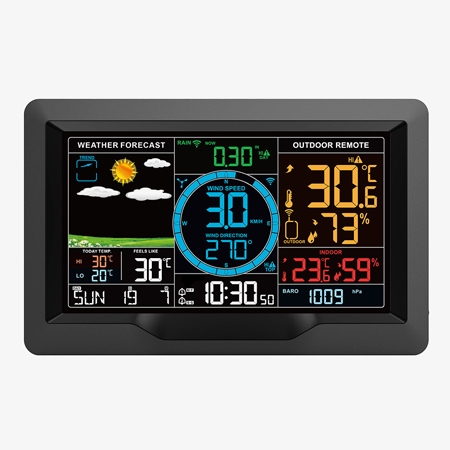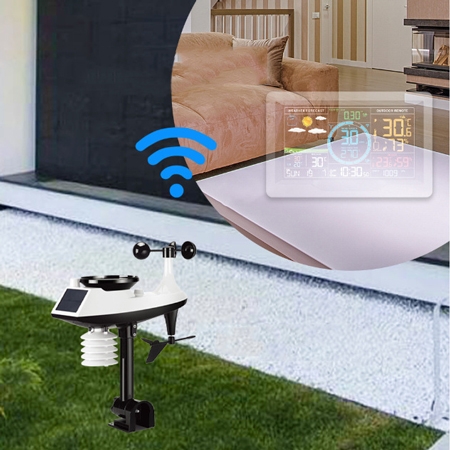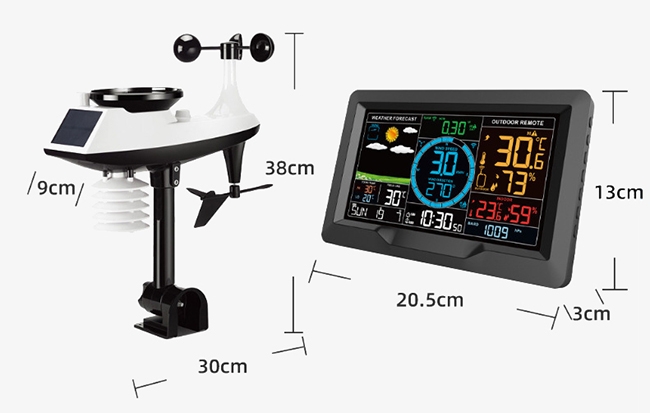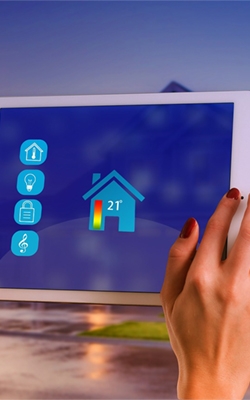SISCO 5-in-1 wireless weather station is a compact and versatile all-in-one device that provides real-time monitoring of key environmental conditions, including temperature, humidity, wind speed, wind direction, and rainfall. The indoor display console features a large LCD screen that clearly shows current readings, historical trends, and weather forecasts.

7.5-inch VA large color screen display
- Color high-definition LCD display: The wifi weather station is equipped with a high-contrast color LCD screen, it clearly displays real-time data, including wind speed, wind direction, temperature, humidity, air pressure, rainfall and other key meteorological parameters, and the interface is intuitive and easy to read.
- WiFi networking function: Supports WiFi network connection, and can automatically upload meteorological data to online platforms such as Weather Underground and WeatherCloud to achieve remote access and data sharing.
- Local air pressure trend and weather forecast icon: Automatically generate trend arrows and weather forecast icons according to air pressure changes to help users judge short-term weather changes (such as sunny, rainy, cloudy, etc.).
- Multiple data recording and playback functions: The wireless weather station supports historical data storage and query, and can view daily, weekly, and monthly temperature and humidity, rainfall, wind speed and other charts for trend analysis and comparison.

Wireless home weather station with the feature of 100-meter transmission distance
- Long-Range Wireless Transmission: The outdoor sensor transmits data wirelessly up to 100 meters (328 feet) in open areas, ensuring stable and reliable communication between the sensor and the indoor display unit.
- Stable Signal Coverage: Even across large gardens or multi-room homes, the system maintains a strong connection without frequent signal loss.
- Perfect for Larger Properties: Ideal for use in spacious yards, farms, or suburban homes where extended range is essential for accurate environmental monitoring.
- Hassle-Free Setup: Easy installation with a strong wireless link that reduces the need for complicated wiring or external boosters.
Dimension

Application
SISCO weather stations are widely used in agriculture, environmental monitoring, scientific research, smart homes, and aviation. They provide real-time data on temperature, humidity, rainfall, wind speed, and atmospheric pressure, supporting both local display and cloud-based access to enable accurate decision-making and automation.

Aviation

Scientific Research

Smart Home

Agricultrue
| Model | SISCO-WS-3390A |
| Indoor Temperature Detection Range | 0~50℃ & 32~122℉ |
| Indoor Humidity Detection Range | 20~95% |
| Indoor Temperature and Humidity Detection Cycle | 60s |
| Outdoor Temperature Detection Range | -40~70℃ & -40~158℉ |
| Outdoor Humidity Detection Range | 20~95% |
| Air Pressure Detection Range | 600~1100 hPa & 17.72~32.48inHg & 450~825.1mmHg |
| Wind Speed Detection Range | 0~180 km/h & 0~111mph |
| Wind Direction Detection Range | 0~359° |
| Rainfall Detection Range | 0~9999mm & 0-393.7in |
| Eight Languages for Selection | English, German, French, Italian, Spanish, Dutch, Danish, Russian |
| Time/date display | √ |
| Dual alarm and snooze function | √ |
| Upper and lower limits for temperature and humidity | √ |
| Upper limit for wind speed | √ |
| Upper limit for rainfall | √ |
| Feeling temperature | √ |
| Wind chill index | √ |
| Heat index | √ |
| Dew point temperature display | √ |
| ASK receiving remote transmitter signal (100m signal transmission) | √ |
| 3 levels of backlight | √ |
Q1: What is a weather station?
A1: A weather station is a device or system that measures and records various atmospheric conditions to monitor and track the weather. It typically includes sensors for temperature, humidity, rainfall, wind speed, wind direction, and barometric pressure. Weather stations can be used for personal, agricultural, scientific, or industrial purposes. In short, a weather station helps you understand and respond to real-time weather changes in your immediate environment.
Q2: Is it worth buying a weather station?
A2: Yes, buying a weather station is often worth it—especially if you want accurate, real-time weather data specific to your location. Unlike general weather apps or forecasts, a personal weather station gives you hyper-local readings on temperature, humidity, rainfall, wind speed, and more, right from your backyard. It’s particularly useful for gardening, farming, outdoor planning, or even home automation when connected to smart systems. Many models offer data logging, app access, and integration with platforms like Weather Underground. While installation and occasional maintenance are required, the ability to monitor and respond to changing conditions makes it a valuable tool for anyone who wants to stay informed and prepared.
Q3: How far should the weather station be from the house?
A3: To ensure accurate readings, a weather station should be placed at least 10 to 20 feet (3 to 6 meters) away from buildings or structures. Here's why:
- Temperature & humidity sensors should be positioned away from walls, windows, air conditioners, or heat sources that can skew the data.
- Rain gauges need an open area where precipitation can fall freely without obstruction.
- Wind sensors (anemometers) work best when mounted at 10 feet (3 meters) or higher in an open, unobstructed area—ideally on a rooftop or a pole away from trees and buildings.
In short, the farther from the house and the more open the space, the better your readings will be.
Tips: Can a weather station predict the weather?
A weather station cannot predict the weather with the same accuracy as professional meteorological services, but it can provide useful data for short-term predictions. By monitoring changes in barometric pressure, temperature, humidity, and wind direction, a weather station can offer clues about upcoming weather patterns, such as the likelihood of rain or storms. Some advanced models even include basic forecasting features based on these trends, helping you anticipate local weather changes over the next 12 to 24 hours. However, for more accurate long-term forecasts, professional weather services are still necessary.
Thank you for buying industrial test and measurement equipment on SISCO.com, all products sold by SISCO and the partner cover a 12 months warranty, effective from the date of receiving the products.
What is covered?
SISCO is responsible for providing free spare parts, and free technical support to assist the customer to repair the defective products until the problem is solved.
What is not covered?
- Product purchased from anyone other than a SISCO store or a SISCO authorized reseller.
- Expendable parts.
- Routine cleaning or normal cosmetic and mechanical wear.
- Damage from misuse, abuse or neglect.
- Damage from use of parts other than SISCO approved.
- Damage from use outside the product’s usage or storage parameters.
- Damage from use of parts not sold by SISCO.
- Damage from modification or incorporation into other products.
- Damage from repair or replacement of warranted parts by a service provider other than a SISCO authorized service provider.
- Damage caused by the application environment not meeting the product usage requirements and the failure to perform preventive maintenance.

